Keywords
|
| ANFIS, Fuzzy Logic, ANN, Simulink, Current source inverters (CSI), Synchronous motor(SM) |
INTRODUCTION
|
The models of synchronous machines widely employed in various areas play important roles in many studies
such as stability and control analysis. Generally, the synchronous machine is a very complex non-linear system with dynamics and non-linearities that cannot be modeled in precise mathematical terms. In order to accurately model the machine, non-classical techniques are needed. Fuzzy logic modeling, neural network and adaptive neuro-fuzzy inference system (ANFIS) modeling have proposed as viable alternatives. These two innovative modeling approaches share some common characteristics: they assume parallel operations; they are well known for their fault tolerance capabilities; and they are often called model-free modeling approaches. On the other hand, neural network modeling is based on artificial neural networks (ANN) that are motivated by biological neural systems. Because of very origins, the respective philosophies and methodologies underlying their problem-solving approaches are quite different and, in general, complementary. As a result, many researchers are trying to integrate these two schemes to generate hybrid models that can take advantage of the strong points of both. This is also the motivation for our research, which aims at providing an integrate framework capable of subsuming both neural networks and fuzzy inference systems. In this study, a model based a hybrid architecture, ANFIS (Adaptive-Network-based Fuzzy Inference System), that can encode a priori knowledge (which can assume various forms of fuzzy if-then rules) into their structures and utilize a fast hybrid learning rule to update their parameters based on a desired input-output data set is introduced and researched to demonstrate its capability to learn the machine behavior. There is a necessity of providing a damper winding in the qaxis to assure the steady-state stability at no-load. Even though the authors of the present study have used the axis model of synchronous motor for analysis of steady state stability, the reference (Korshunov, 2009) has drawn the attention because such work relates with the state variable model. Chattopadhyay et al. (2011) does not involve synchronous motor as a topic of research but the main similarity lies in the fact that this study also uses Laplace transforms as a tool for mathematical modeling using state variable approach applied to solar array power system. According to Jazaer et al. (2011) synchronous motor can be included playing the role of the symbol of the motor shown in the Fig.1 and 2. Babainejad and Keypour (2010) analysed the effect of electrical parameters of an Induction Generator on the transient voltage stability of a variable speed wind turbine system. Furthermore this study uses the torque balance equations in the phase model which can be converted to d-q model using the well-known torque balance equation i.e., Te = id Ψq.-Ψd iq. There are many representative form of transfer function in association with the steady state stability analysis of a Current Source Inverter fed synchronous motor (CSIFSM) drive system. Taking the practical aspect into account, the present study targets to derive an expression in a suitable form for transfer function which is the ratio of the Laplace transfer of the small signal version of the change in angle (β) between the field (rotor) m.m.f. axis and armature (stator) m.m.f. axis to the Laplace transform of the small signal version of change in load torque (TL). The objective of the study is to diagnose the fact whether the synchronous motor with damper winding and fed through a current source inverter can sustain small perturbation in load torque or not. This analysis has been carried out from the view point of the concept of steady state stability criteria of an electrical drive system. |
| In this article, CSI fed synchronous motor having an equivalent circuit with unequal stator and rotor mutual inductances and coupling inductances between d-axis rotor circuits is modeled by using the ANFIS. |
| The principal advantage of neuro-fuzzy control (ANFIS), i.e., fast convergence with adaptive step size of the control variable, is retained. The neural network adds the advantage of fast control implementation and computation. Such a neuro-fuzzy control combines the advantages of fuzzy and neural controls. ANFIS which tunes the fuzzy inference system with a back propagation algorithm based on a collection of input-output data is implemented here. One of the parameter in the works done by various authors, being the settling time of the responses and the proper selection of the rule base in the fuzzy control strategy, which was not yielding good results. The responses had taken a lot of time to reach the final steady state value. In this paper, a sincere attempt is made to reduce the settling time of the responses and make the speed of response very fast by designing an efficient controller using ANFIS control strategy, which is the main contributory work of this paper. The proper rule base was selected using an intelligently developed back propagation algorithm, which has yielded excellent results compared to the others mentioned in the literature survey above. The results of our work have showed a very low transient response and a non-oscillating steady state response with excellent stabilization and we have tried to improve the dynamic performance of the developed controller by developing a sophisticated adaptive neuro fuzzy algorithm. The remaining of the article is organized as follows. Section 2. Mathematical Modeling and Equivalent Circuit of CSI Fed Synchronous Motor. The Steady State Stability Controller Design is given in the section 3. Section 4. includes ANFIS Modeling for SSSA showing effect of winding parameters on the steady state performance of the synchronous motor . Section 5 illustrates results and discussion obtained using the ANFIS model. Finally, Section 6 contains conclusions. |
MATHEMATICAL MODELING AND EQUIVALENT CIRCUIT OF CSI FED SYNCHRONOUS MOTOR Construction
|
| The salient-pole construction is used in low-speed alternating current (AC) machines i.e. synchronous motors (see Fig1). This type of machine usually has a large number of poles for low-speed operation, and a large diameter-tolength ratio. The field coils are wound on the bodies of projecting poles. A damper winding (which is a partial squirrelcage winding) is usually fitted in slots at the pole surface for synchronous motor starting and for improving the stability of the machine. |
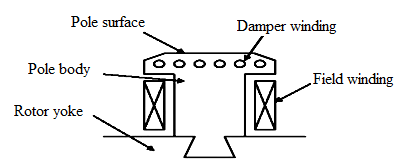 |
| Fig.1 Salient Pole Rotor Construction |
d-q Theory for Synchronous Machine without Damper Winding
|
Park’s Transformation
|
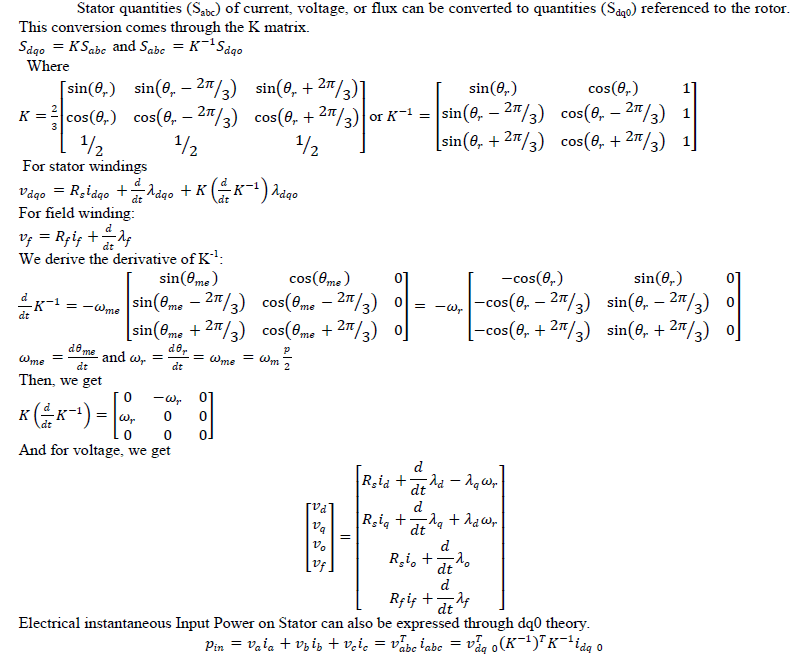 |
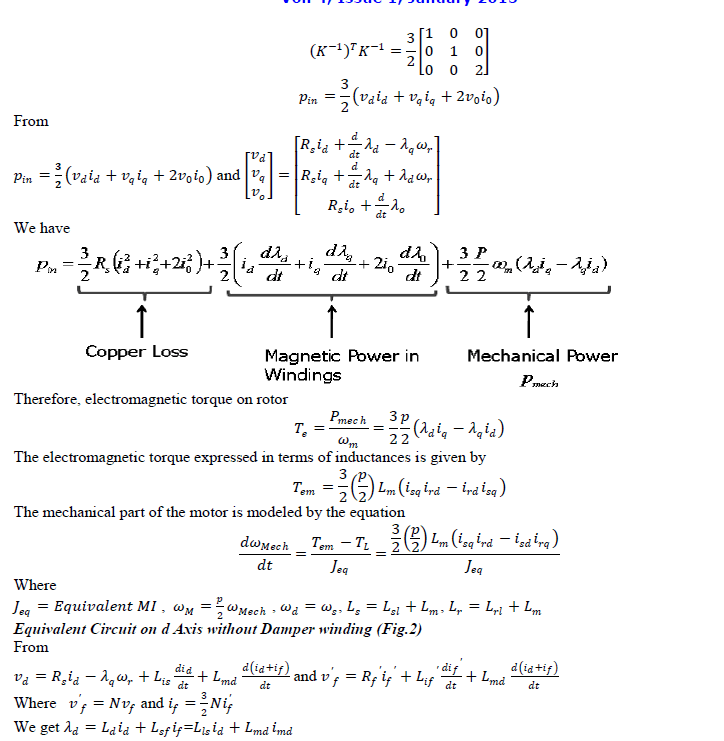 |
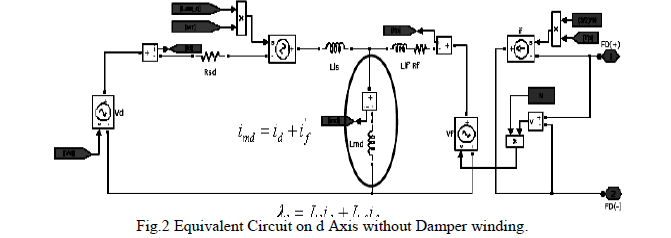 |
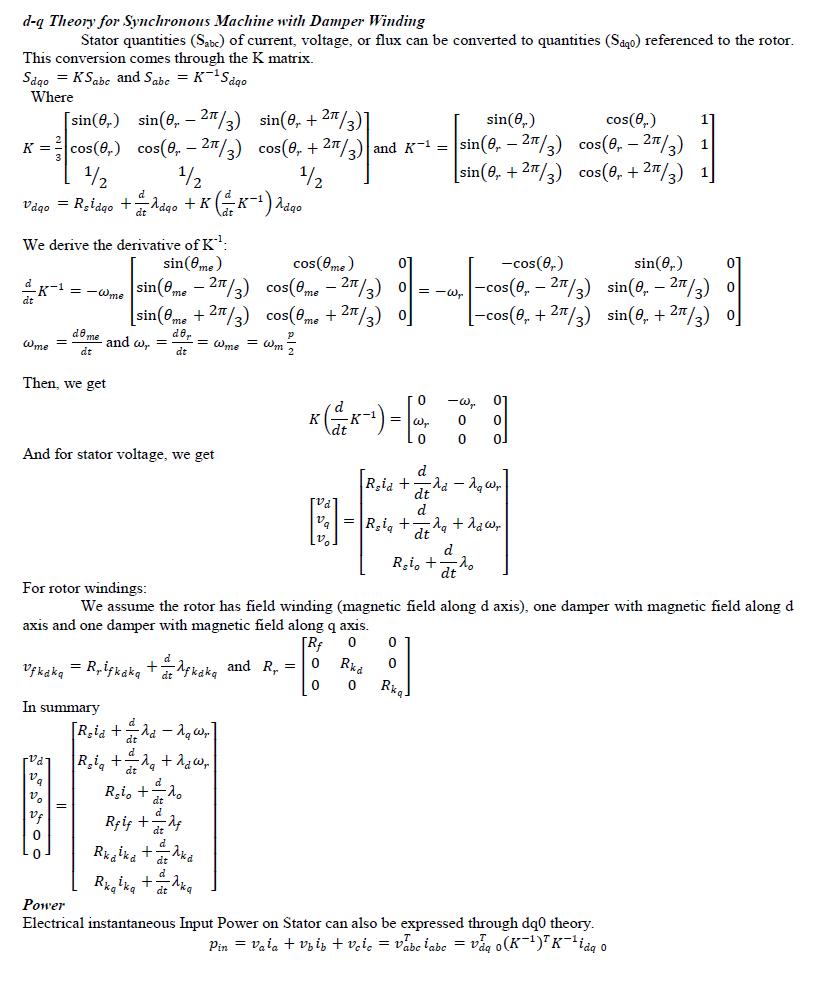 |
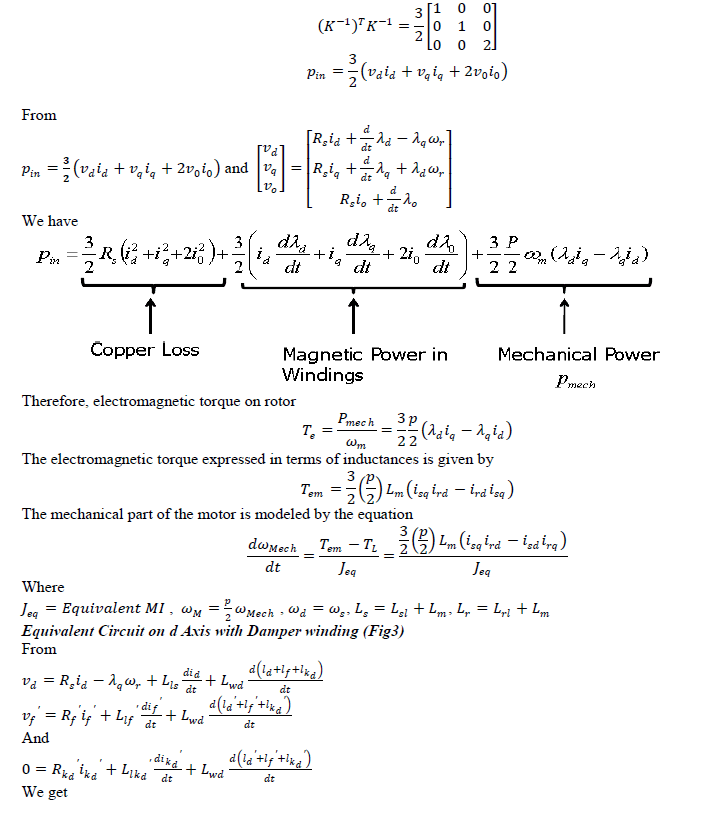 |
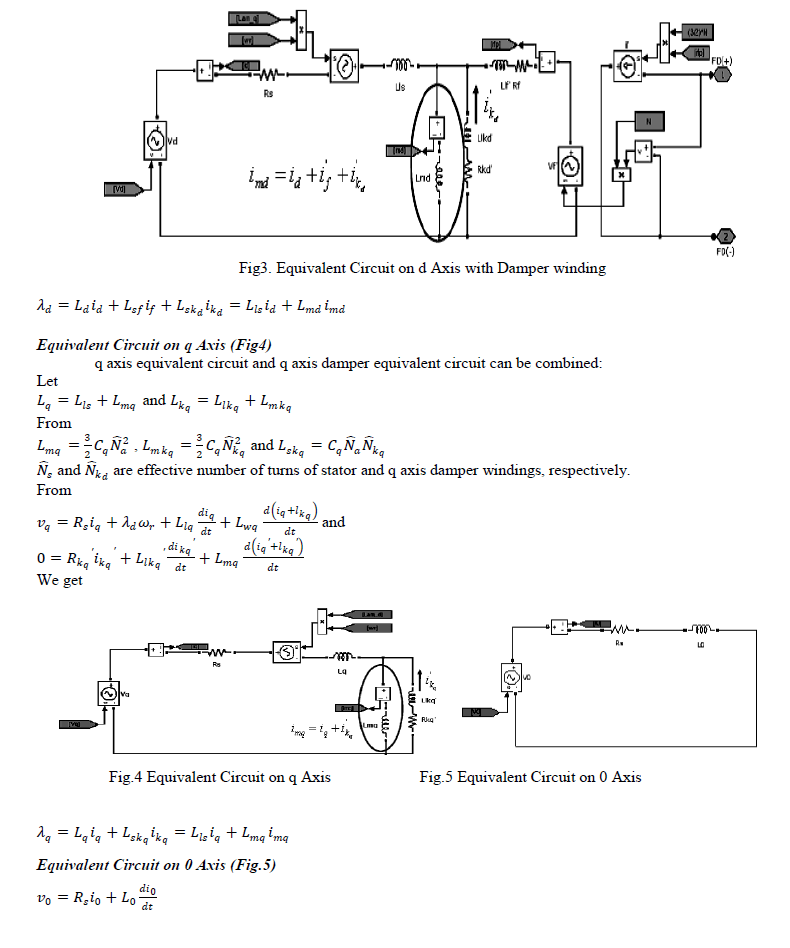 |
STEADY STATE STABILITY CONTROLLER DESIGN
|
| A controller is a device which controls each and every operation in the system making decisions. From the control system point of view, it is bringing stability to the system when there is a disturbance, thus safeguarding the equipment from further damages. It may be hardware based controller or a software based controller or a combination of both. In this section, the development of the control strategy for control of various parameters of the synchronous motor such as the speed, flux, torque, and voltage, current is presented using the concepts of ANFIS control scheme, the block diagram of which is shown in the Fig. 6. To start with, we design the controller using the ANFIS scheme. |
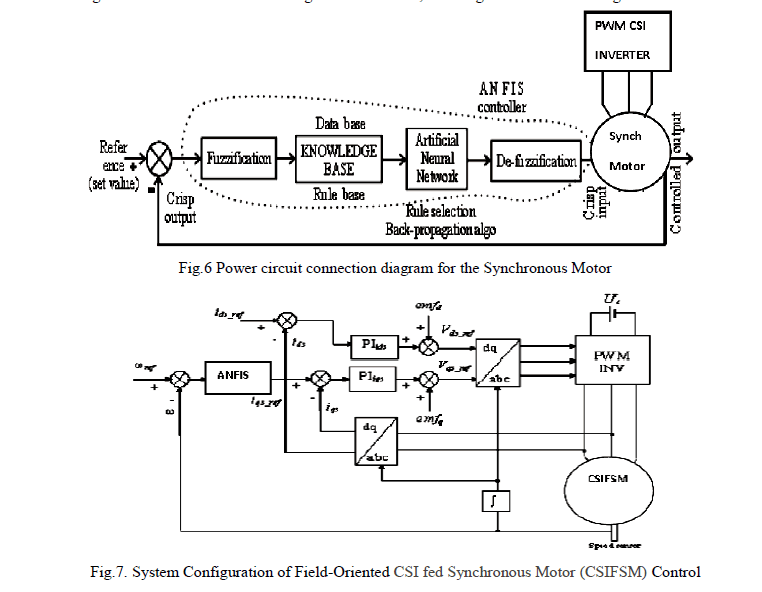 |
| Fig.7. shows system configuration of field-oriented CSI fed synchronous motor (CSIFSM) Control using ANFIS architecture. A fuzzy logic controller is based on a set of control rules called as the fuzzy rules among the linguistic variables. These rules are expressed in the form of conditional statements. Our basic structure of the developed ANFIS coordination controller to control the speed of the synchronous motor consists of 4 important parts, viz., fuzzification, knowledge base, neural network and the de-fuzzification blocks, which are explained in brief in further paragraphs. The inputs to the ANFIS controller, i.e., the error and the change in error is modeled as |
 |
| Where ÷ref is the reference speed, ÷r is the actual rotor speed, is the e(k) error and Δe(k) is the change in error. The fuzzification unit converts the crisp data into linguistic variables, which is given as inputs to the rule based block. The set of 49 rules are written on the basis of previous knowledge/experiences in the rule based block. The rule base block is connected to the neural network block. Back propagation algorithm is used to train the neural network to select the proper set of rule base. For developing the control signal, the training is a very important step in the selection of the proper rule base. Once the proper rules are selected and fired, the control signal required to obtain the optimal outputs is generated. The output of the NN unit is given as input to the de-fuzzification unit and the linguistic variables are converted back into the numeric form of data in the crisp form. In the fuzzification process, i.e., in the first stage, the crisp variables, the speed error and the change in error are converted into fuzzy variables or the linguistics variables. The fuzzification maps the 2 input variables to linguistic labels of the fuzzy sets. The fuzzy coordinated controller uses the linguistic labels. Each fuzzy label has an associated membership function. The membership function of triangular type is used in our work. The inputs are fuzzified using the fuzzy sets and are given as input to ANFIS controller. The rule base for selection of proper rules using the back propagation algorithm is written as shown in the Tab. 1. The developed fuzzy rules (7×7) is included in the ANFIS controller and is not shown here for the sake of convenience. The control decisions are made based on the fuzzified variables in the Tab. 1. The inference involves a set of rules for determining the output decisions. As there are 2 input variables and 7 fuzzified variables, the controller has a set of 49 rules for the ANFIS controller. Out of these 49 rules, the proper rules are selected by the training of the neural network with the help of back propagation algorithm and these selected rules are fired. Further, it has to be converted into numerical output, i.e., they have to be de-fuzzified. |
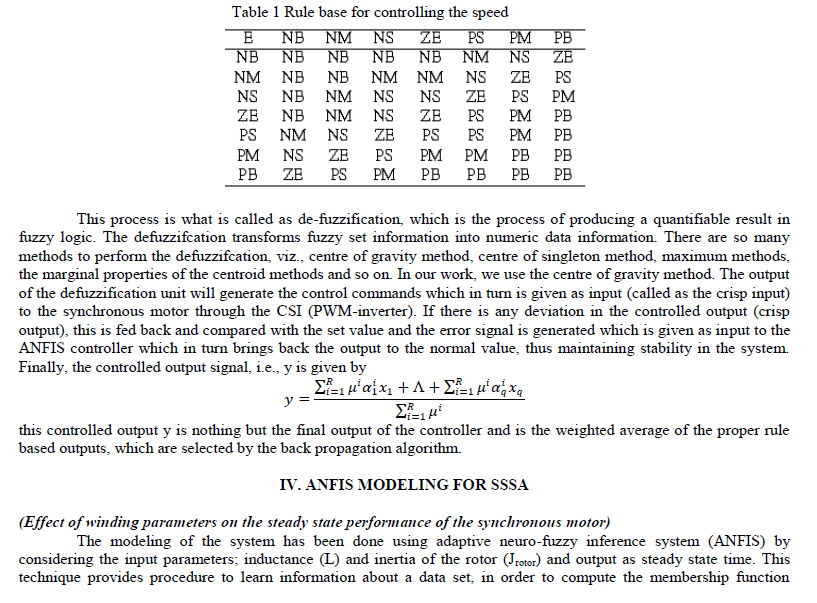 |
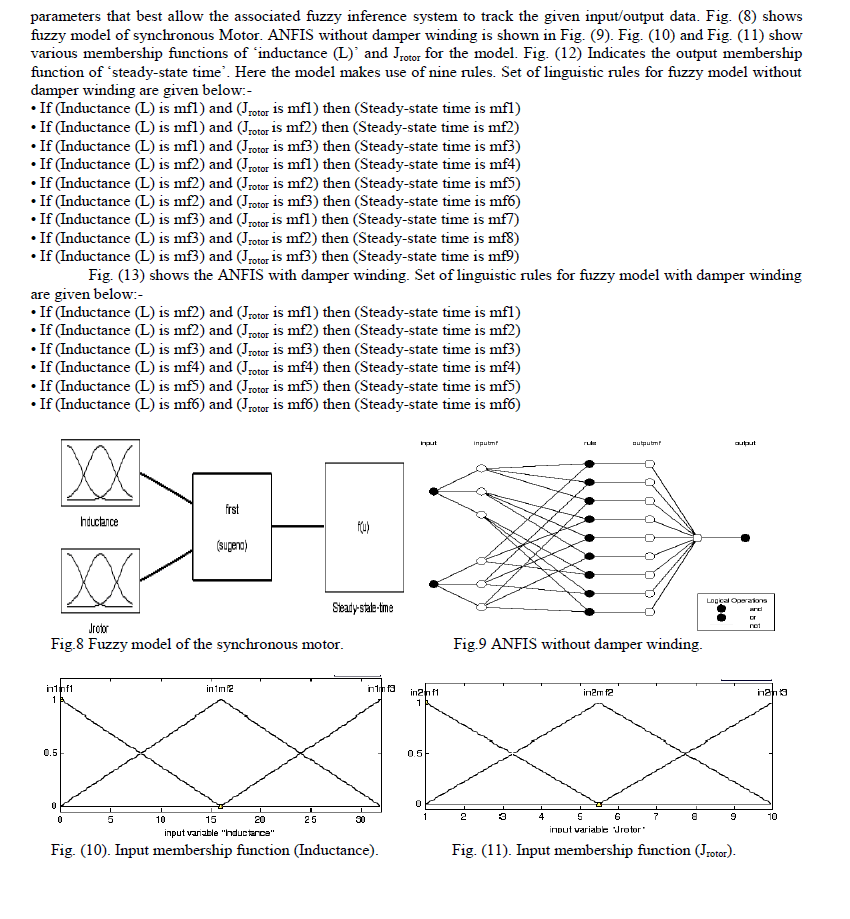 |
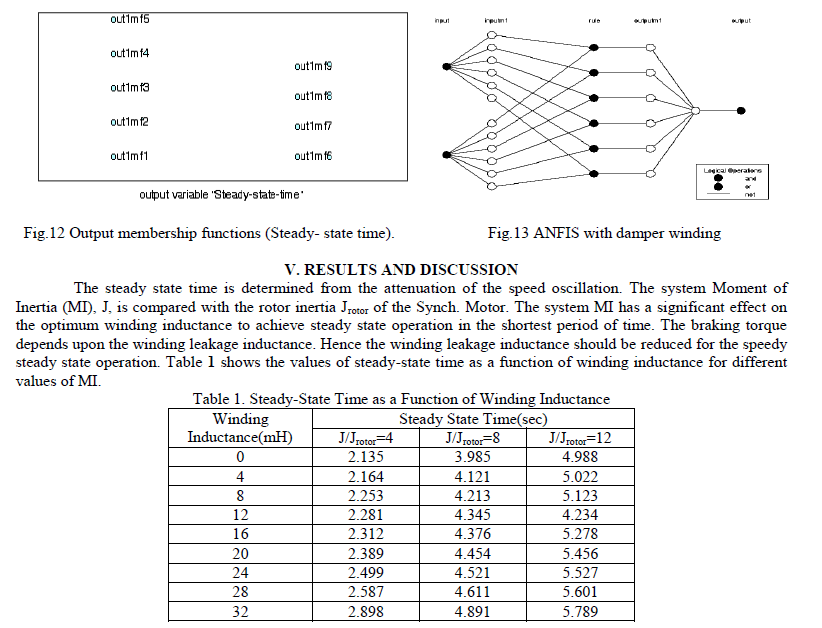 |
| Fig.(14) shows the rule viewers for the synch. motor without damper winding for a particular case when J/Jrotor=4 and inductance of 20mH for which the output i.e. steady-state time is 2.502 seconds, which deviates from the value given in the table 1. Fig.(15) shows the rule viewers for the synch. motor with damper winding for J/Jrotor=4 and inductance of 20mH. The output i.e. steady state time in this case is 2.389 seconds which is matching the value obtained by conventional analysis method. |
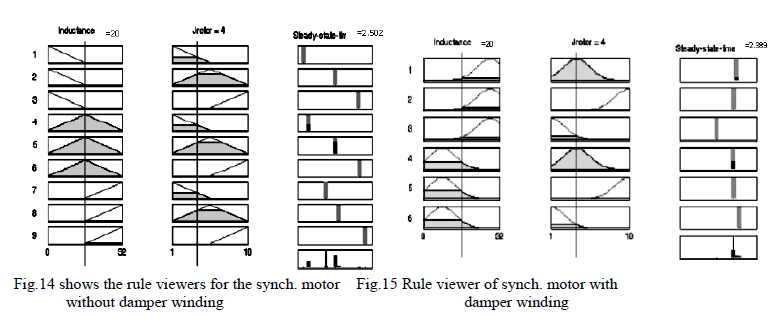 |
| Fig. 16 shows variation of stator currents (Isabc) with respect to time (rad/sec) with ANFIS controller. Fig. 17 illustrates variation of speed with respect to time with ANFIS Controller. Fig. 18 shows response at speed of 650 rad/s with ANFIS Controller. Fig. 19 illustrates effect on speed after disturbance of torque from 4 Nm to 8 Nm at the instant of 0.025 seconds with ANFIS Controller. Fig. 20 shows ANFIS Model Structure with 2 and 1 outputs 4Layers of ANFIS Architecture. Variation of Speed (rad/sec.) with respect to inputs to Time with ANFIS Controller in shown in Fig. 21. Fig. 22 illustrates variation of three phase stator current rad/sec with respect to time with ANFIS Controller and Fig. 23 shows step response at speed of 650 rad/sec with ANFIS Controller. Step Response for Fuzzy logic and ANFIS Controller is shown in Fig. 24. |
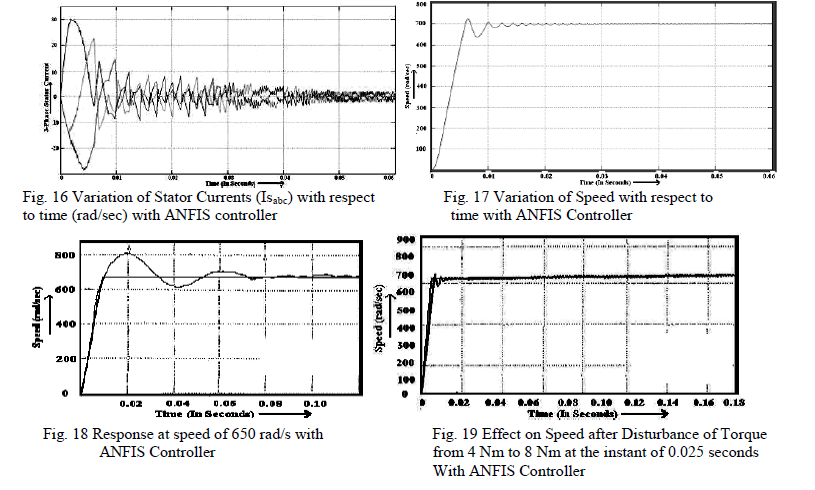 |
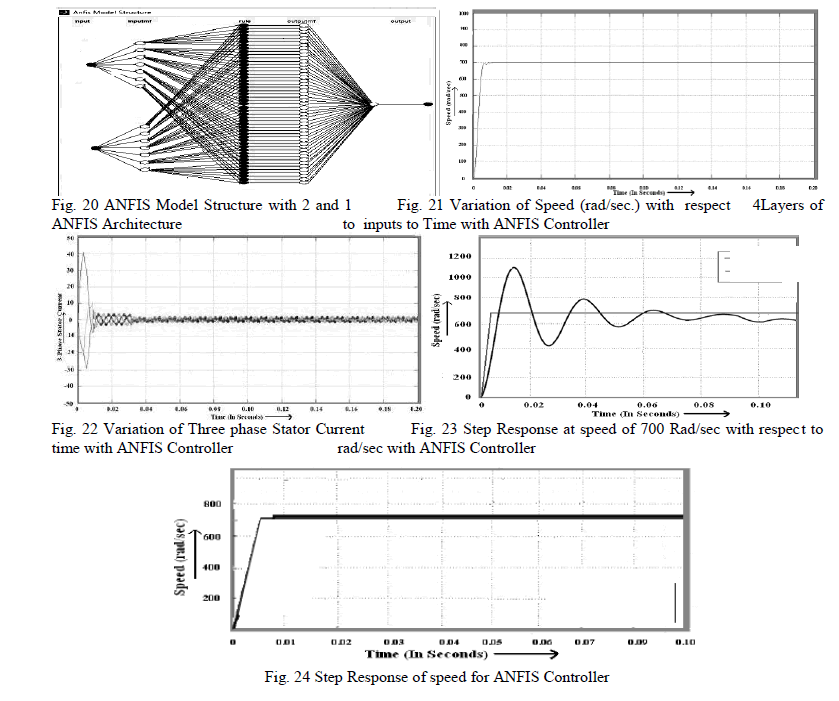 |
CONCLUSIONS
|
| This paper presents the steady state stability analysis of CSI fed synchronous motor using ANFIS. The effect of rotor moment of inertia (MI) and the optimum winding parameters on the steady state operation of the synchronous motor (SM) is the studied by ANFIS technique and hence the steady state time of the SM can be reduced. The rules extracted from data can be validated by experts, and combined with their prior knowledge to obtain a complete system model describing the reality over the entire domain of interest. From the simulation results, it can be observed that the characteristic curves of the synchronous motor (SM) take less time to stabilize and due to the incorporation of the ANFIS controller, it was observed that the motor reaches the rated speed very quickly comparatively. The main advantage of the developed ANFIS coordination scheme is to increase the steady state stability performance and to provide good stabilization. Also, the proposed ANFIS scheme is computationally efficient, works well with linear techniques, optimization and adaptive techniques. Another advantage of the ANFIS being, the task of training of membership functions is done in ANFIS, which is not taken care of in the fuzzy counterpart. The developed control strategy is not only simple, but also reliable and may be easy to implement in real time. From the simulation results, it is found that the ANFIS model produces better speed response than conventional methods in terms of rise time, overshoot, settling time and steady state. ANFIS model has significantly reduced the overshoot as well as the settling time in comparison to rest of conventional models. It also cancelled the disturbance effects such as speed and torque change and maintained steady-state accuracy. The ANFIS model has significantly reduced the time of steady state stability for designing an optimal Neuro-Fuzzy Controller. |
References
|
- Aware, M., Kothari, A., and Choube. S., (2000) ?Application of adaptive neuro-fuzzy controller (ANFIS) for voltage source inverter fed
- induction motor drive?. in: The Third International Electronics and Motion Control Conference— IPEMC 2000, Beijing, Vol. 2, pp. 935–939.
- Bose, B., Patel, N.andRajashekara K. (1997) ?A neuro-fuzzy-based on-line efficiency optimization control of a stator fluxoriented direct
- vector-controlled induction motor drive?. IEEE Transactions on Industrial Electronics, 44(2): 270–274.
- Consoli, A., Cerruto, A.,andRaciti. A. ?Adaptive vector control of induction motor drives based on a neuro fuzzy approach?. IEEE, 20-25 Jun
- 1994, Vol. 1, pp. 225–232, Taipei.
- 4. Dote, Y., Fujino, Y., Suyitno. A. ?Neuro fuzzy robust controllers for AC drive systems?. in: IEEE International Conference on Industrial
- Electric, Control, & Instrumentation, IECON‘93, 15-19 Nov 1993, Vol. 3, pp. 2311–2316.
- 5. GCD, S., Bose, B., Cleland. J. (1995) ?Fuzzy logic based on-line efficiency optimization control of an indirect vector controlled induction
- motor drive?. IEEE Transactions on Industrial Electronics, Vol. 42, Issue 2, pp. 192–198.
- 6. Kusagur, A., Kodad, S., and Ram. B. (2009) ?AI based design of a fuzzy logic scheme for speed control of induction motors using SVPWM
- technique?. International Journal of Computer Science and Network Security, Vol. 9, Issue 1, pp. 74–80.
- 7. Kusagur, A., Kodad, S., Ram. B. (2009) ?Modelling of induction motor & control of speed using hybrid controller technology?.in: Proceeding
- of International; Journal of Theoretical Information &Technolog, Issue 2, Vol. 10, pp.117–126.
- 8. Kusagur, A., Kodad, S., Ram, B. (2010) ?Novel design of a Takagi-Sugeno fuzzy strategy for induction motor speed control?. Journal of
- Electrical Systems, 6(2).
- 9. Miloudi, A., Radadi, E. A., et al. (2004) ?Simulation and modelling of a variable gain PI controller for speed control of a direct torque neuro
- fuzzy controlled induction motor drive?. in: 35th Annual IEEE Power Electr. Specialists Conference, Vol. 5, PESC-04, Aachen, Germany,
- pp.3493–3498.
- 10. Nasir, M., Hao. W. ?Model reference adaptive flux observer based neuro-fuzzy controller for induction motor drive?. IEEE paper, 2-6 Oct.
- 2005, IAS-2005, Vol. 2, pp. 1279–1285.
- 11. Rashidi. F. ?Sensorless speed control of induction motor derives using a robust and adaptive neuro-fuzzy based intelligent controller?. in: IEEE
- International Conference an Industrial Technology, 8-10 Dec. 2004, Vol. 2 , pp. 617 - 627.
- 12. Zhang, Y., Jiang, Z., Yu. X. (2008), ?Indirect field-oriented control of induction machines based on synergetic control theory?. in: IEEE
- International Conference on Power and Energy Society General Meeting—Conversion and Delivery of Electrical Energy in the 21st Century, 7,
- vol. 1, pp.20–24.
- 13. Dipl.-Math. Elena Zhelezina, ==Adaptive Finite Element Method for the Numerical Simulation of Electric, Magnetic and Acoustic Fields‘‘,
- Ph.D.Thesis, University of Nuremberg-Erlangen, Germany 2005.
- 14. Singh, A., Sharma, A.K., Kamal, T.S. Vishal and Singh, P. (2007) ?A comparative analysis using Fuzzy modeling and OptSim on WDM
- systems in the presence of FWM and compensation technique”, Journal of Scientific and Industrial Research (JSIR), National Institute of
- Science Communication and Information Resources (NISCAIR) New Delhi, India, vol. 66, pp. 339-344.
- 15. Jang, J.S.R. (1993) ==ANFIS: Adaptive-network-based fuzzy inference system‘‘, IEEE Transactions on Systems, Man, and Cybernetics, pp.
- 665-685.
- 16. KrovelOystein, ?Design of Large Permanent Magnetized Synchronous Electric Machines?, Ph.D thesis, Norwegian University of Science and
- Technology, Trondheim, pp 6-10, 14-15 Feb 2011.
- 17. Radovan, Dolec, Jaroslav, Novak, and OndrejCerny, (December 2009) ?Traction Permanent Magnet Synchronous Motor Torque Control with
- Flux Weakening? IEEE Transactions on Radio-Engineering, Vol. 18, No 4.
- 18. Kaewjindaweera and KonghirunMongkol, (Feb 2007) ?Vector Control Drive of Permanent Magnet Synchronous Motor Using Resolver
- Sensor?, ECTI Transactions of Electrical Engineering, Electronics and Communications Vol.5,No. 1.
- 19. Korshunov, A.I., (2009). ?Analysis of the static stability of a synchronous motor with permanent magnets by the classical method?. Russ.
|